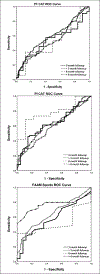PROMIS and FAAM Minimal Clinically Important Differences in Foot and Ankle Orthopedics
- PMID: 30282469
- PMCID: PMC6698160
- DOI: 10.1177/1071100718800304
PROMIS and FAAM Minimal Clinically Important Differences in Foot and Ankle Orthopedics
Abstract
Background:: Establishing score points that reflect meaningful change from the patient perspective is important for interpreting patient-reported outcomes. This study estimated the minimum clinically important difference (MCID) values of 2 Patient-Reported Outcomes Measurement Information System (PROMIS) instruments and the Foot and Ankle Ability Measure (FAAM) Sports subscale within a foot and ankle orthopedic population.
Methods:: Patients seen for foot and ankle conditions at an orthopedic clinic were administered the PROMIS Physical Function (PF) v1.2, the PROMIS Pain Interference (PI) v1.1, and the FAAM Sports at baseline and all follow-up visits. MCID estimation was conducted using anchor-based and distribution-based methods.
Results:: A total of 3069 patients, mean age of 51 years (range = 18-94), were included. The MCIDs for the PROMIS PF ranged from approximately 3 to 30 points (median = 11.3) depending on the methods being used. The MCIDs ranged from 3 to 25 points (median = 8.9) for the PROMIS PI, and from 9 to 77 points (median = 32.5) for the FAAM Sports.
Conclusions:: This study established a range of MCIDs in the PROMIS PF, PROMIS PI, and FAAM Sports indicating meaningful change in patient condition. MCID values were consistent across follow-up periods, but were different across methods. Values below the 25th percentile of MCIDs may be useful for low-risk clinical decisions. Midrange values (eg, near the median) should be used for high stakes decisions in clinical practice (ie, surgery referrals). The MCID values within the interquartile range should be utilized for most decision making.
Level of evidence:: Level I, diagnostic study, testing of previously developed diagnostic measure on consecutive patients with reference standard applied.
Keywords: FAAM; MCID; PROMIS; orthopedics; pain; patient-reported outcomes; physical function.
Figures


References
-
- Askew RL, Kim J, Chung H, Cook KF, Johnson KL, Amtmann D. Development of a crosswalk for pain interference measured by the BPI and PROMIS pain interference short form. Qual Life Res. 2013;22(10):2769–2776. - PubMed
-
- Beaton DE, van Eerd D, Smith P, et al. Minimal change is sensitive, less specific to recovery: a diagnostic testing approach to interpretability. J Clin Epidemiol. 2011;64(5):487–496. - PubMed
-
- Carmont MR, Silbernagel KG, Nilsson-Helander K, Mei-Dan O, Karlsson J, Maffulli N. Cross cultural adaptation of the Achilles tendon Total Rupture Score with reliability, validity and responsiveness evaluation. Knee Surg Sports Traumatol Arthrosc. 2013;21(6):1356–1360. - PubMed
MeSH terms
Grants and funding
LinkOut - more resources
Full Text Sources
Medical
Research Materials
Miscellaneous

